| Please access the following URL if you want to secure using SSL. All pages in the site will be secure pages. |
https://secure02.blue.shared-server.net/www.fish-food.co.jp/message english 3.2023.html |
Welcome to FISH FOOD TIMES
Mar. 2023 issue No.231

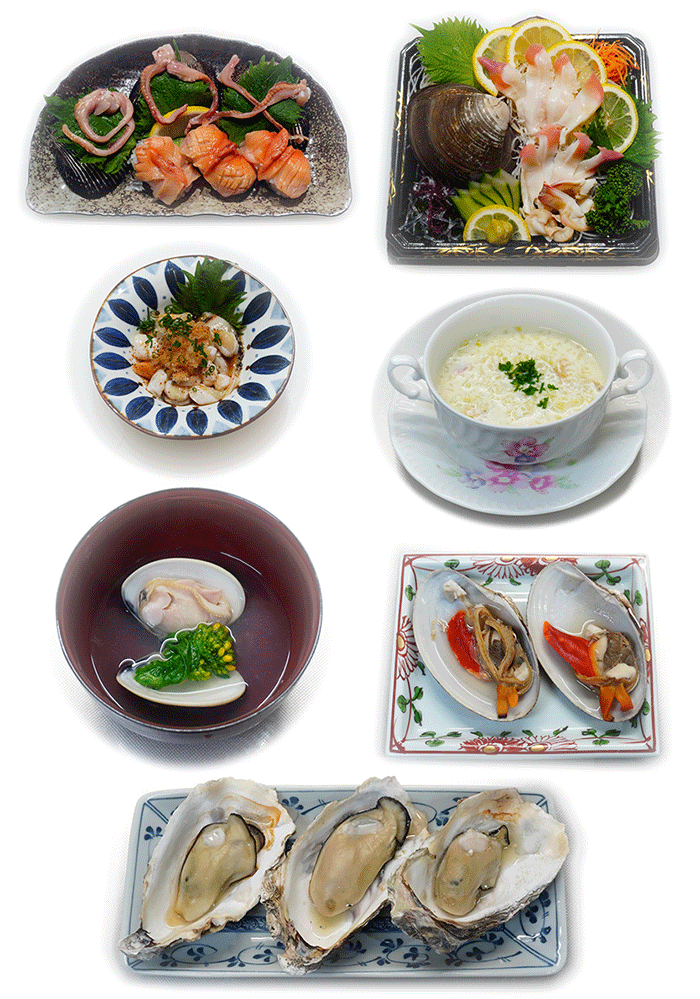
Shellfish dishes
Beginning of shellfish season
I believe that March 1st of every year marks the beginning of the shellfish season. It is customary to eat Japanese hard clam during the Doll's Festival on March 3rd, and clam sales explode only once a year on this day. If Japanese hard clam is eaten in ordinary households, it seems that there are many places where it is really only on the day of the Doll's Festival once a year. However, when the price of domestically produced Japanese hard clam exceeds 2,000 yen/kg, and one piece of Japanese hard clam costs several hundred yen, people cannot buy it either, and have endured with the same bivalve Japanese little neck. That's why Japanese little necks have been selling so well at the Doll's Festival for so many years now. In this way, Japanese little necks and Japanese hard clams start selling at once in March. Therefore, I have been thinking that this is the beginning of the shellfish sales season for those involved in the fisheries industry, and that the sales system should be set up accordingly.
However, on January 30th (Sunday) last year, a TBS news feature was broadcast with the theme of "imported Japanese little neck disguised as a domestic production area", and this broadcast triggered a decline in sales of Japanese little neck at the fish market from February. Since then, the market price of domestically produced Japanese little neck has risen to around 2,000 yen/kg, and Japanese little neck has disappeared from the fish market.Even if it were to be sold, domestically produced Japanese little neck costs 250 yen per 100g, and even Chinese-made Japanese little neck sells for 150 yen per 100g. Currently, there is a fact that one online sales website sells 1 kg of domestically produced Japanese little neck for 4,100 yen/kg.
In 2022, clams will not sell at all due to this incident, and one year has passed since then, and I thought that it would be about time to cool off with "something about people's rumors". However, on December 13, it was discovered that a seafood processing company in Arao City, Kumamoto Prefecture had sold more than 7,000 tons of imported short-necked clams under the guise of domestic production,and the company received corrective guidance from the Agricultural Administration Bureau.
I feel "Really incorrigibly..." about this, and as a person involved in the fisheries industry, I can't help but sigh. However, it is useless to lament all the time, so in March, which is seen as the beginning of the shellfish season, I thought that I would try to plan something like ``Help boost the demand for shellfish'' on this website. Therefore, I decided to go to the fish market, which I have been familiar with for a long time, and purchase a Japanese hard clam as one of the subjects.
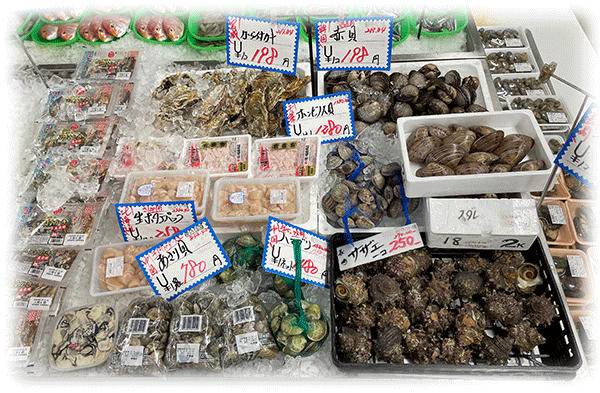
This store has an assortment of shellfish like this. Located in Kurume City, Fukuoka Prefecture, this supermarket specializes in fresh produce, and the fish section is particularly attractive. It's not uncommon for customers like me to drive from Fukuoka, spend an hour, and come to this store just to buy fish. This is a typical example of how the charm of a fish market expands the business area of a store.
I have not applied for coverage of this store, and I have not received the company's consent. For this reason, the specific name of the store will be withheld. The bustle for about 30 minutes after the store opens at 10:00 is just extraordinary. As soon as the store door opens, dozens of customers who have been waiting in line outside the store entrance really "run" to the fish counter. And they rush to choose the fresh fish that are lined up in the raw fish section that sells naked. Then, they deliver the fish to the employees waiting in the workshop as soon as possible, and three people in the workshop receive the whole fish, and the scene of dismantling the fish continues. In this way, fish are sold one after another, and in just 30 minutes after the store opens, hundreds of thousands of dollars can be sold, resulting in explosive sales. It is a very rare and very prosperous fish market these days.
At some point in the past, the company was doing badly as a company and was eventually acquired by another company. I was invited as a consultant by the new president who was seconded from the company that acquired the company, and I was allowed to guide the fish department for five years. And the company has turned around spectacularly over the last five years. And the president at the time was recognized for his exceptional performance recovery skills, and was commended by the parent company that acquired the company.
I really like the business style of the fish section of this store. I am still friends with the employees, and this store is an indispensable presence for me. If you ask me what I like about this fish market, my immediate answer would be "the naked selling style of raw fish boasting a wonderful selection". This has been a feature of the company since before I started teaching it, and I don't think that I have done anything special about this. This is the same characteristic as before, and I think that style matches my way of thinking and sensibility, and is the reason why the author's instruction in the fisheries department went well. At that time, as a consultant, I remember that I put a lot of effort into providing guidance during training, especially regarding the product line of sushi and sashimi, as well as counting management. Unfortunately, however, I did not feel that I was able to improve the sashimi category of the sashimi product line. Even now, when I look at the sashimi section, I feel regret that something could have been done a little better.
On that day, in the shellfish section of the store, there was an adductor muscle of the razor shell made in Korea for about 300 yen per piece. Adductor muscle of the razor shell, which costs about 500 yen per piece from the Ariake Sea, was also on sale. And razor shell offal, now a delicacy, was also sold for 980 yen per pack. In addition, there were scallops, turban shells, domestically produced Japanese hard clams, Korean produced Japanese hard clams, hardshell clam, tokobushi abalone, shelled oysters, peeled oysters, Japanese little neck, and surf clams. However, the abalone, which is always in stock, was out of stock that day. And there was a shell that I was able to see for the first time this time. It is the image below.
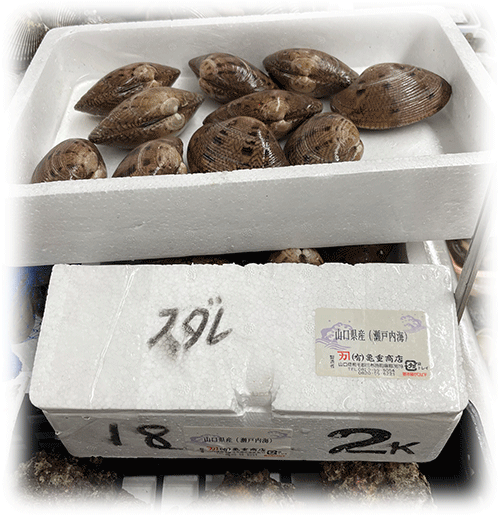
This is a shellfish named Sudaregai that arrived from Tabuse Town, Yamaguchi Prefecture. The manager of the fish market, who has been in the business for nearly 50 years, has only seen it once in the past, and other veteran employees also said that it was the first time they had seen it. It is classified in the genus Sudaregai, subfamily Ryukyu clam, in the family Marsudaregai, and its origin is that the black vertical lines that intersect the growth line look like bamboos forming a blind.
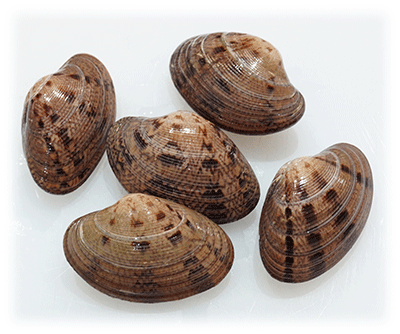
I took this clam home and kept it in a large bowl filled with salt water together with the japanese little neck, oysters, japanese hard clam, hardshell clam, etc. that I had purchased until I cooked it. Then, while I was doing other work, I heard a loud rattling noise, so I looked at the ball and saw that this sudare shellfish was moving around vigorously, making the sound of shells colliding with each other.
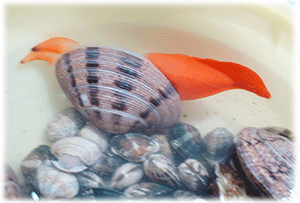
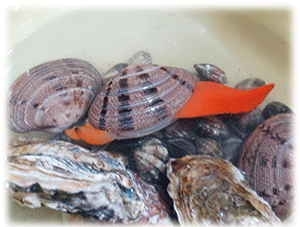
The sudare shellfish moved by extending and retracting its legs quickly, and the other shellfish, such as the Japanese little neck, surprisingly closed their shells tightly to protect themselves. I generally had the impression that shellfish were slow to move, but I was surprised by the agility of this sudare shellfish using its large red legs that extend and contract. When I opened the shell, the red legs were surprisingly small, but the unique color gave off a presence.
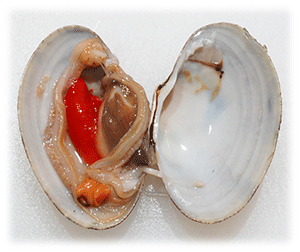
1,Sudare shellfish sake steamed
I had never seen Sudare shellfish before, so I was very curious as to what it tasted like, but I opted for the simpler form of sake steamed.
| Sudare shellfish sake steamed |
|---|
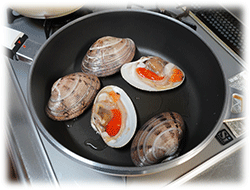 |
| 1, Put the sudare shellfish in a frying pan and add 4 tablespoons of sake. |
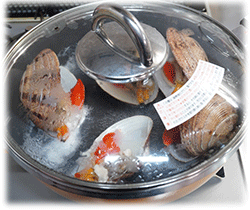 |
| 2, The shell opened unexpectedly quickly, and I had to wait two minutes. Immediately turn off the heat and finish cooking. |
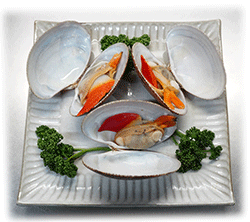 |
| 3 servings of both shells of sudare-gai |
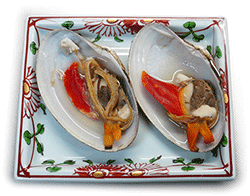 |
| 2 servings of half shells of sudare-gai |
Shellfish dishes
Purchasing sudare clams was unexpected, and when things turned out like this, it suddenly became interesting, and since clams are in the season when they are delicious, I thought I would try cooking various clams, not just Japanese hard clam. And what I had in mind was to make the red clam sushi instead of sashimi, the surf clam as sashimi instead of sushi, the razor shell's internal organs in vinegar as usual, and the oysters as fragrant grilled oysters. Hardshell clam, which has been trending recently, was a standard clam chowder, and the original main purpose of Japanese hard clam was to make it soup as planned.
For those involved in the fisheries industry, the following article may not be very fresh knowledge and may not be learned, but I would appreciate it if you could find even one useful piece of information. Including sudare shellfish, I would like to describe the cooking process for each type of shellfish in order below.
2,The internal organs of the razor shell
The second shell is the razor shell. It is also the internal organs of the razor shell, which has now become a delicacy. At this store, azor shell scallops from Korea are 2,580 yen for 9 pieces, so one piece is about 300 yen. And a pack of 3 from the Ariake Sea costs 1,380 yen per 100g, so one piece costs about 500 yen. Among these products, the internal organs of the razor shell, which is now treated as a delicacy, were sold for 980 yen per pack.
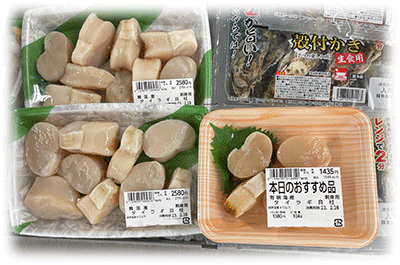
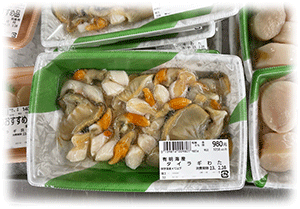
If there was a razor shell with a shell, I might have purchased it for figure sashimi, but unfortunately there was no arrival on this day. For this reason, I did not purchase scallops, which cost 500 yen each, but purchased only the internal organs of the razor shell and cooked them as follows.
| Vinegared from the internal organs of the razor shell | |
|---|---|
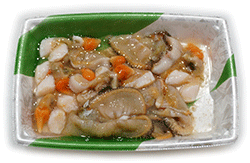 |
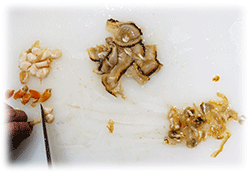 |
| 1, The internal organs of the razor shell purchased for 980 yen per pack | 4. It is up to the person to decide how much to clean. |
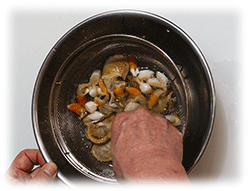 |
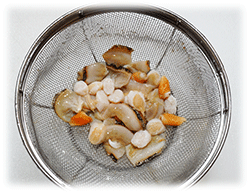 |
| 2. Wash with light salt water. | 5, The internal organs after washing with salt water |
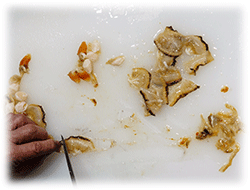 |
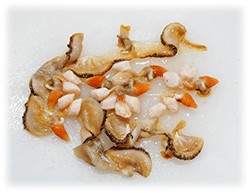 |
| 3,Remove the adhering parts such as internal organs | 6Internal organs such as hakama, legs, and muscles |
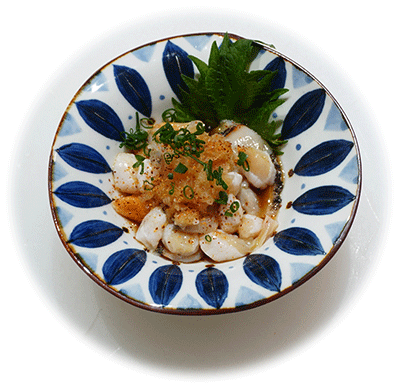 |
|
| 8,Serve with grated daikon radish and sprinkle with chopped green onions and ichimi. This completes Vinegared from the internal organs of the razor shell. | |
By the way, I don't have a razor shell image with a shell on hand, so I borrowed the following image from the internet and pasted it.
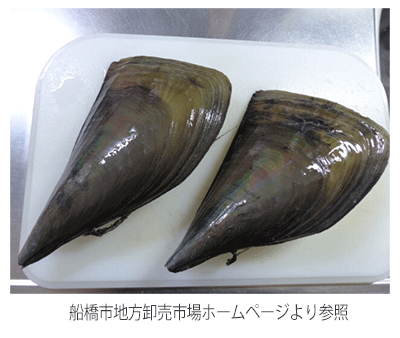
In the past, when a lot of razor shells were caught in the Ariake Sea, internal organs were a common food, apart from the adductor muscles. However, now razor shells are rarely caught in the Ariake Sea, and internal organs have become a delicacy and have joined the ranks of luxury goods.
3,surf clam
Next is the surf clam. I don't know how many surf clams were originally put in the big basket of the aquarium, but I bought the last one.
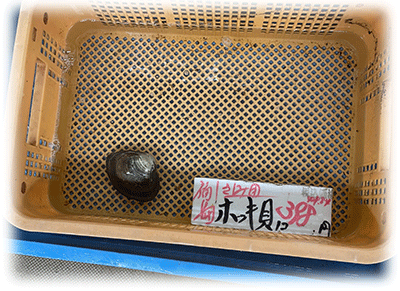
One piece is 398 yen even if it is said that it is a large one as a surf clam. I think that the purchase price of surf clam sushi that can be purchased in a frozen vacuum pack is 20 to 30 yen per piece, so this is a high-class shellfish because it costs more than 10 times. This was made into figure sashimi with a shell as follows.
| Figure sashimi of surf clam | |
|---|---|
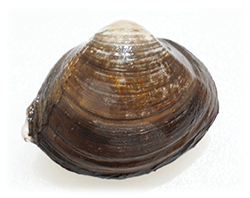 |
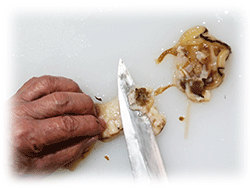 |
| 1, surf clam | 6,After making the leg into kannonbiraki, the internal organs attached to the cut open leg are scraped off with the edge of the blade. |
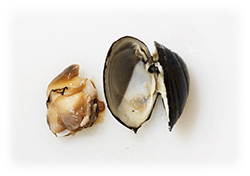 |
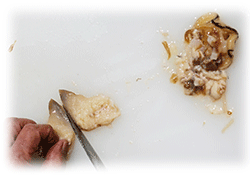 |
| 2,Open the shell of the clam and take out the contents. | 7,After shaving off the internal organs, separate the kannonbiraki legs into two. |
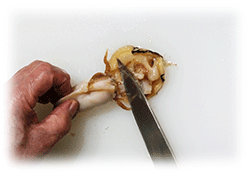 |
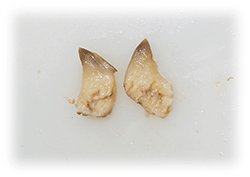 |
| 3,With the legs up and the internal organs down, make a cut in between. | 8,A leg that has been cleaned of internal organs and separated in two |
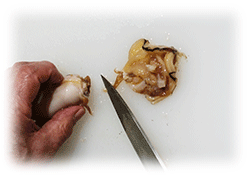 |
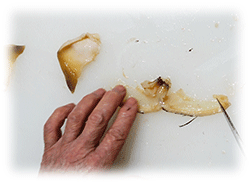 |
| 4,Separate the legs and internal organs. | 9,Clean the hakama part with a kitchen knife. |
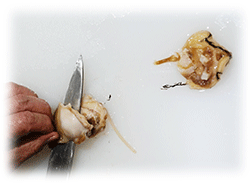 |
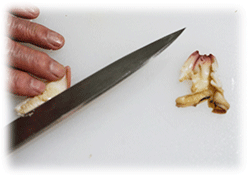 |
| 5,Place the tip of the foot on the left and cut from the base on the right to make kannonbiraki. | 10、After lightly boiling the edible part in thin salt water, it is made into usutsukuri sashimi. |
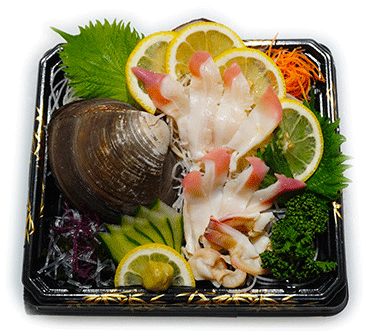 |
|
| surf clam figure sashimi using bivalve shells | |
This is exactly "the leftovers are lucky", and I felt that the thin sashimi of the surf clam was very sweet and really delicious.
4,red clam
Red clams are made in Korea, so they are relatively cheap, it was piled up like the image below and was sold for 198 yen per piece.
s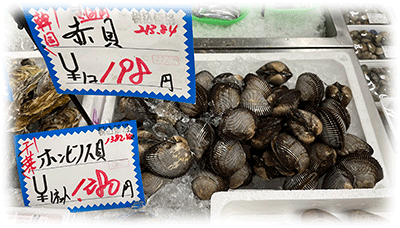
Red clams contain the same hemoglobin as human blood, which is rare among shellfish. When cooking, the cutting board is dyed red, but when sashimi and sushi are made, the color is red and looks good, so it is a useful shellfish for increasing the added value of sashimi and sushi products. However, the catch of domestic fish has decreased dramatically, making it extremely valuable and expensive.
I only bought 3 this time. After thinking about how to make it look nice, I decided that I had no choice but to use shells. For nigiri sushi, this method may be an evil way, but I tried to make red clam's nigiri sushi look nicer by putting shells in the tray for fun and decorating the part called string on top of it.
| Red clam nigiri sushi | |
|---|---|
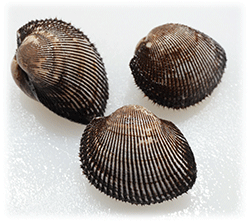 |
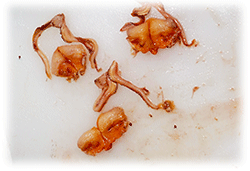 |
| 1,I prepared 3 red clams. | 7,Cleaned with a kitchen knife and removed the internal organs. After that, rub it with salt to remove slime. |
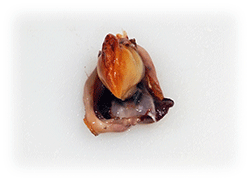 |
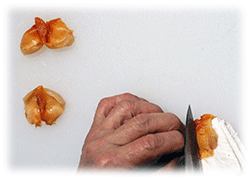 |
| 2,Red clam with the shell removed. | 8,Make a decorative knife with a Kanoko pattern. To do this, place a ball of bleaching cloth or kitchen paper under the red clam. This makes it easier to make decorative knives. |
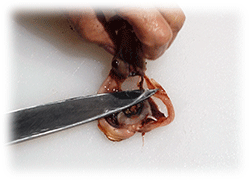 |
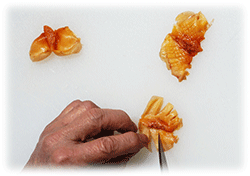 |
| 3,Grasp the foot part and cut a notch at the base between the internal organs part to separate it. | 9,Make a decorative knife with a butterfly pattern. |
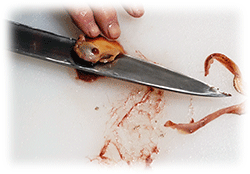 |
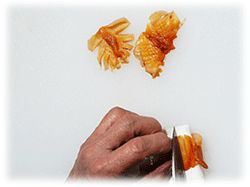 |
| 4,With the protruding part of the foot on the left, cut open from the other side to make kannonbiraki. | 10,Make decorative cuts at equal intervals vertically. |
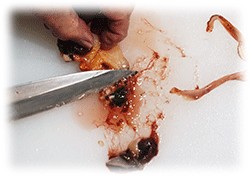 |
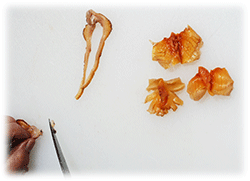 |
| 5,Scrape off the internal organs remaining on the leg where kannonbiraki was done with the tip of the blade. | 11,Scrape off the blood and dirt on the string with the tip of the blade. |
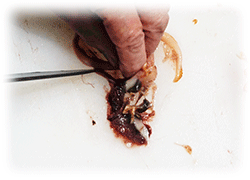 |
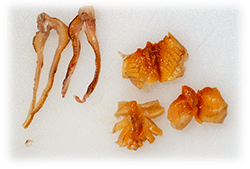 |
| 6,Cut off and remove the gills attached to the part called string. | 12,Finished the decorative knife and finished cleaning the string. |
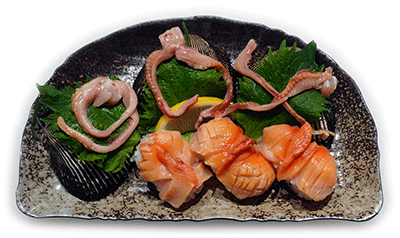 |
|
| 13,By arranging the scallop shells and decorating them with string, the nigiri sushi was skillfully produced. | |
5,hardshell clam
As you can see in the image below, one bag of 16 pieces sold for 1,280 yen is hardshell clam, which has recently attracted a lot of attention.
s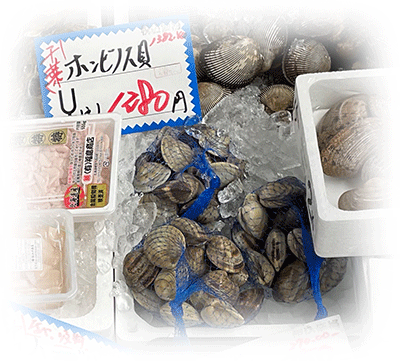
When you take it out of the bag, it looks like a Japanese hard clam at first glance.
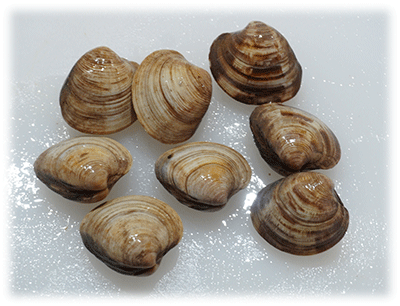
Please see the image below to see the difference from the japanese hard clam.
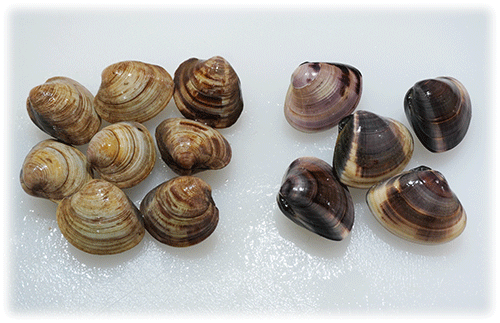
Left is hardshell clam and right is Japanese hard clam. If you compare them side by side, you can understand the difference well, but if only the hardshell clam is placed, you can mistake it for the Japanese hard clam.
Previously in Japan, this shellfish belonged to the genus Venus, so it was called the Venus shellfish (Binosu). After that, the Japanese name became Binosugai, and since "hon" was added to it, it is honbinosugai. Other names are Ooasari, Shirohamaguri, and Oohamaguri. However, none of them are valid as official names, and such names should not be used at the fish market.
This hardshell clam did not originally inhabit Japan and was discovered in Tokyo Bay in 1998. It is speculated that this shellfish adhered to the hull of a ship and came to Japan from the North American continent where it originated. This shellfish is an important edible shellfish in the United States and is widely fished. Breeding in Japan has been confirmed relatively recently, and it was often treated as a nuisance because it inhabits many Japanese little neck fishing grounds. However, it is resistant to low salinity, can live in water areas where Japanese little neck and Japanese hard clam cannot live, is easy to remove sand, and has gained popularity in recent years due to its good taste.
A famous dish using this hardshell clam is clam chowder. This is a well-known specialty of San Francisco's tourist attraction, Fisherman's Wharf. Clam is a general term referring to bivalves, and it is a clam chowder that is put in a hollowed round bread with a soup made of seafood and vegetables called chowder. The image below is clam chowder.
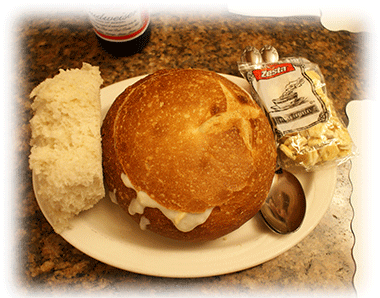
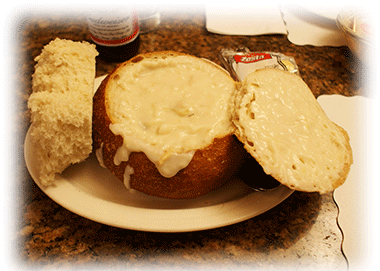
This image is the clam chowder I ate when I went to San Francisco in 2009. The image on the upper left shows the inside of the round bread being hollowed out, the soup inside and the lid on. A piece of hollowed out bread is attached to the right side of the plate, which can also be eaten. The upper right image shows the lid removed so that the soup can be seen. Of course, you can also eat the bread on the lid. It was a dish with an interesting idea of hollowing out a piece of bread and using it as a cup to put the soup inside. I could not have imagined this at all, and I remember him being very surprised.
This time, I decided to try to make clam chowder with the hardshell clam I bought on that day.
| clam chowder with the hardshell clam | |
|---|---|
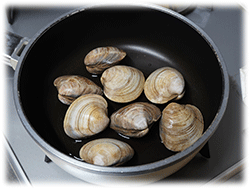 |
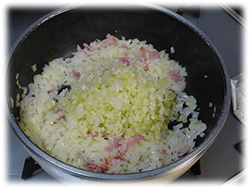 |
| 1,Place 8 hardshell clams in the frying pan and add 2 tablespoons of white wine. | 8,When the onion is cooked through, add a coarsely chopped celery stick. |
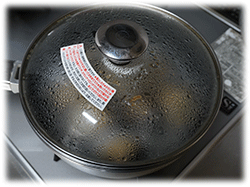 |
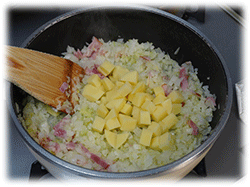 |
| 2,Close the lid and wait for the shell to open. | 9,Cut the potatoes into 5mm squares and add them in a stir fry. |
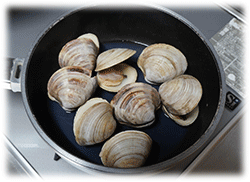 |
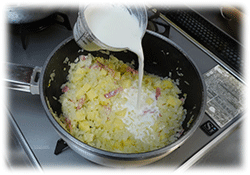 |
| 3,As soon as the shell opens, turn off the heat and let it cool in another place. Don't throw away the wine clam juice. | 10,Add 400ml of milk. |
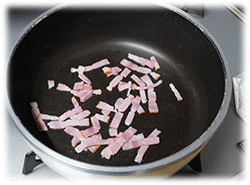 |
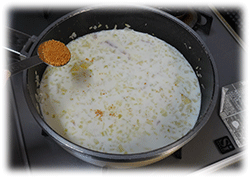 |
| 4,Cut 2 strips of bacon into strips and stir fry until browned. | 11,Add 1 teaspoon of consomme. |
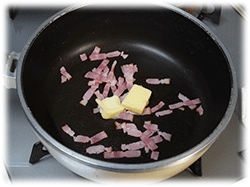 |
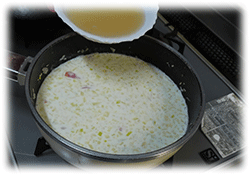 |
| 5,Add 10g of butter | 12,Add the wine clam juice that was steamed in the frying pan that was left separately. |
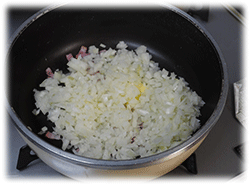 |
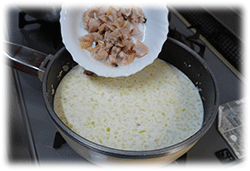 |
| 6,Add coarsely chopped onion. | 13,Remove the contents of the hardshell clam from the shell, cut into quarters, and add at the end. |
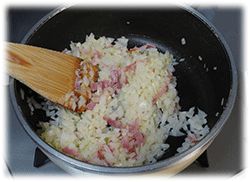 |
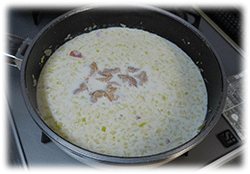 |
| 7,Stir fry until onions are cooked through. | 14,Slowly simmer over low heat for 30 minutes, stirring occasionally, taking care not to bring to a boil. |
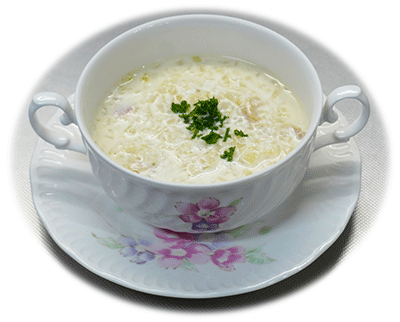 |
|
| Topped with chopped parsley to finish, the clam chowder is completed. | |
The finished clam chowder with the hardshell clam is more like a "soup to eat with lots of ingredients" than a soup to drink. It had a good milk flavor, was very delicious, and had a high degree of perfection. This clam chowder dish does not seem to be very common yet, and it seems to be a good dish proposal to sell the product called hardshell clam.
6,oysters with shell
The sixth shellfish is the oyster. Peeled oysters are the mainstream these days, and oysters with shells seem to be less popular. Peeled oysters also have a range from A to B, and among them are "bargain salted raw oyster packs" that are made to blister in salt water and shrink as soon as they are baked, becoming a pitiful size. are sold at. When purchasing oysters, be careful not to prioritize only price. In that respect, there is no way to deceive oysters with shells, so whether they are fat or thin is determined by the selection of the place of production and the season.
I tried to make grilled oysters that can eat oysters with shell in the simplest and most delicious way. There is also a method of baking with the two shells still attached, but I prefer the method below.
| Grilled oysters with shell | |
|---|---|
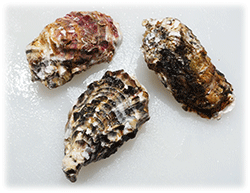 |
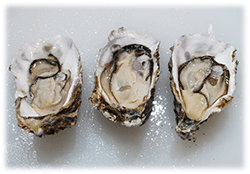 |
| 1,Three oysters with shell from Miyagi were prepared. | 5,The inside of the round shell is not voluminous and does not look good if left alone. |
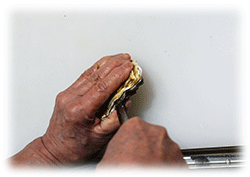 |
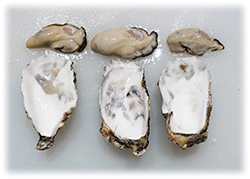 |
| 2,Insert the tip of the shell tool along the inside of the flattened shell. | 6,Remove the contents from the shell. |
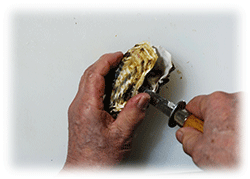 |
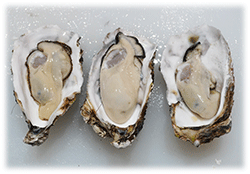 |
| 3,Aim at the position of the adductor muscle and move the tip of the metal around. | 7,On the other hand, if you turn it over and put the contents in the shell, even a round shell will give a sense of volume and look better. |
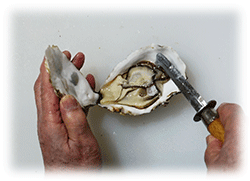 |
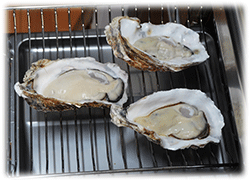 |
| 4,Once the shell lid has loosened slightly, lift the flat shell with your left hand to open the shell. | 8,Put it on the grill without adding any seasoning. |
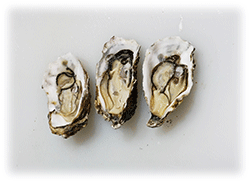 |
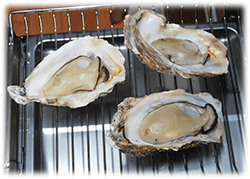 |
| 5,The state where the contents remain in the rounded shell. | 9,The oyster has a moderate color and the grilling is finished. |
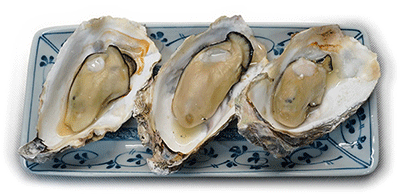 |
|
| Grilled oysters with shell is delicious as it is without any special seasoning. | |
7,japanese hard clam soup
Finally, it is the Japanese hard clam which was the main purpose of this time. I bought it from Chiba, so it may be from the famous Kujukurihama, but I didn't check that far.
On the other hand, in the Kafuri district of Itoshima City, Fukuoka Prefecture, there is a purely domestic natural Japanese hard clam that is rare in Japan and is sold under the name of 'Chikuzen Kafuri natural clam'. The Kafuri Branch of the Itoshima Fisheries Cooperative has organized a hamaguri association to protect the resources of the Japanese hard clam, and conducts resource management-type fisheries that decide on restrictions such as the fishing season and catch size. Japanese hard clam fishing is limited from November to the end of March.
Purely domestic Japanese hard clams caught in Kujukuri Beach, Chiba Prefecture and Kafuri, Fukuoka Prefecture are extremely valuable and expensive, and depending on their size, one piece usually costs hundreds of yen. This time, the writer was given a special service price of 700 yen for 5 pieces of Japanese hard clam from Chiba. As the Doll's Festival approaches in March, don't be surprised if similar domestically produced Japanese hard clams sell for several times this price.
Using the purchased Japanese hard clam, I made the following Japanese hard clam soup, which is supposed to be the main character at the Hinamatsuri on March 3rd.
| japanese hard clam soup | |
|---|---|
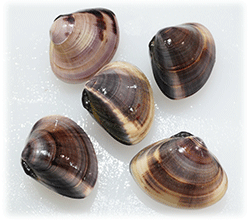 |
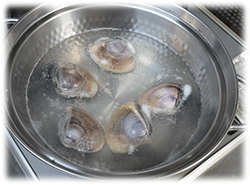 |
| 1,Five domestically produced Japanese hard clams were prepared. | 3,Boil slowly over low heat and wait for the shells to open. |
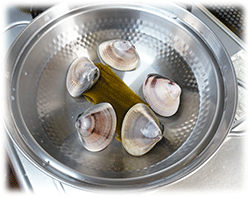 |
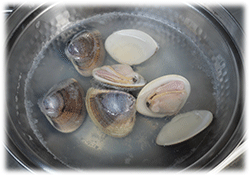 |
| 2,Soak the kelp in water for 30 minutes before adding the japanese hard clam. | 4,Since the heat was low, it took a surprisingly long time for the shells to open, and it took more than 8 minutes for the first one to open. |
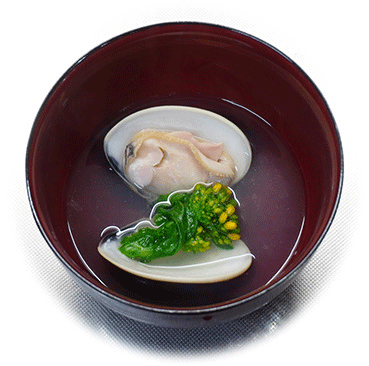 |
|
| The soup is seasoned with salt and soy sauce, and finished with salt-boiled rape blossoms. | |
Let's sell shellfish products in March
By the way, I think that this month's issue has somehow become an article with content that seems to be FISH FOOD TIMES. This month's theme was "I want you to rediscover the charm of shellfish and lead to sales promotion of shellfish."
The problem with using shells as a theme is that if you only have one type of shell, it is very difficult to draw a story and then expand it as a story. For example, if we focus only on the Japanese hard clam, we will not be able to fill the space unless we expand the content of the article to cover the history and culture unrelated to the sale of fish. This time, I was troubled at the stage where I had to think in advance, but luckily I came across sudare shellfish. I am very grateful to sudare shellfish because that encounter provided me with the clue to solve my problem.
For that reason, this time I tried to make it a total readable content that collects seven types of shellfish. As a result, although it has become a long paper, it is not up to the author to know how deep the content will be evaluated, but it will depend on the impressions of the readers.
As an auther, I would like to provide readers with a way to fight against the sales of shellfish, which has been facing a headwind since last year. By all means, I want you to increase the sales of shellfish products this year.
| Please access the following URL if you want to secure using SSL. All pages in the site will be secure pages. |
https://secure02.blue.shared-server.net/www.fish-food.co.jp/message english 4.2023.html |
An opinion and the communication are to iinfo@fish food times
Date of updating 1 Mar. 2023
